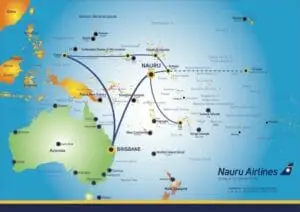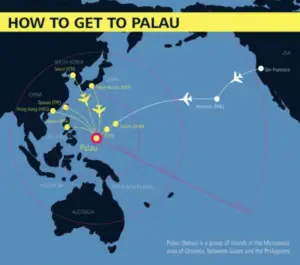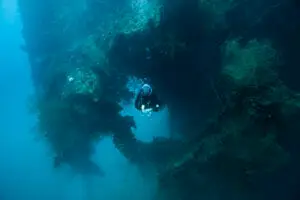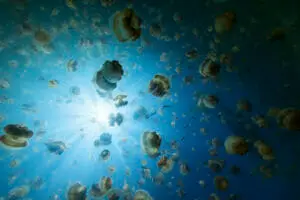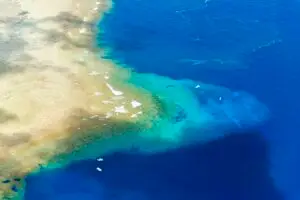There are dive sites and then there’s Blue Corner.
Tucked into the crystal waters of Palau’s barrier reef, Blue Corner isn’t just another spot on the map. It’s a place where the ocean pulses with life.
Where the current lifts you like flight, schools of barracuda spin overhead, and sleek reef sharks slice effortlessly through the blue. Ask any diver who’s been: this is where stories are made.

At Palau Dive Adventures, we’re lucky enough to call Blue Corner part of our daily routine. We dive it often. We know its rhythms. And we still get excited every single time we drop in.
This guide is here to help you understand what makes Blue Corner one of the best dive sites in the world, whether you’re a newly certified diver or have hundreds of dives under your belt.
You’ll learn how the site works, what kind of marine life to expect, when to go, how reef hooks come into play, and how to experience it all safely, respectfully, and unforgettably.
Because diving Blue Corner isn’t just a thrill—it’s a privilege.
Table of Contents
Why Blue Corner Is World-Famous
Ask any diver who’s been to Palau what their favorite dive was, and chances are, they’ll say Blue Corner.
But why does this site consistently top lists of the best dive sites in the world? It’s not hype, it’s the rare combination of underwater topography, wildlife, and current dynamics that make Blue Corner an experience unlike any other.
Location & Geographic Magic
Blue Corner is located on the outer edge of the Ngemelis Reef system, about 26 kilometers (16 miles) southwest of Koror.
It’s where two massive reef walls—one running north-south, the other east-west—converge at a sharp underwater promontory. This creates a corner-shaped plateau that juts into the open ocean, exposed to deep-water currents and pelagic life.
What does that mean for divers?
Constant water movement. Fresh nutrients. Big animals. Big action.
🧭 Local tip from our Palau Dive Adventures team: When you look at the site on a chart, it doesn’t look like much. But underwater, it’s a different story entirely—the reef bends the ocean itself.
The Underwater Terrain
The main action happens on a sloping plateau at around 15–25 meters (50–80 feet), with steep drop-offs on both sides. Small coral bommies, sandy pockets, and natural channels run across the shelf.
These features create ideal ambush zones for predators and perfect spots to anchor a reef hook.
To the west, the reef wall plummets straight into the abyss. The drop is so dramatic, on calm days, you can hover and look down into pure, infinite blue. It’s both humbling and breathtaking.
The Famous Current: Friend, Not Foe
Blue Corner is known for its strong, unpredictable currents, but that’s what makes it so special. Incoming tides bring nutrients from the deep, attracting sharks, tuna, jacks, and schooling fish in numbers you rarely see elsewhere. It’s a dive site that transforms based on timing, tide, and moon phase.
Most dives start with a negative entry and a quick descent to avoid drifting off. Once in position, divers “hook in” to the reef using a reef hook and let the current push past them like an underwater wind tunnel. You’re stable, yet completely immersed in movement.
💡 Pro tip: Every current direction reveals a different side of Blue Corner. We’ve dived it hundreds of times—and no two dives are the same.
The X-Factor: Controlled Chaos
What sets Blue Corner apart isn’t just the marine life or the reef structure. It’s the pure energy of the site. The anticipation as you descend. The way your body feels suspended mid-water.
The wall of fish parts like a curtain when a shark glides through. The sense of privilege that you’re here, witnessing this.
And while other sites may be beautiful or thrilling, Blue Corner somehow manages to be both, at full volume.
Quick Summary:
Location: Western Ngemelis Reef, ~45–60 min boat ride from Koror
Topography: Plateau at 15–25 m, vertical drop-offs, reef walls on two sides
Why it’s famous: Shark action, schooling fish, intense currents, reef hook dives
Best for: Advanced divers or confident intermediates with drift experience
Unique to this guide: Local insights, planning tips, reef dynamics explained
Marine Life at Blue Corner
The real stars? The ones with fins.
Thanks to its position at the edge of the deep ocean and the constant flow of nutrient-rich current, Blue Corner offers some of the most consistent big fish encounters in the world. It’s one of those rare places where “what might I see?” turns into “what won’t I see?”
Here’s a look at the marine life you’re likely to encounter and a few surprises only locals know to look for.
The Shark Show (And Why It’s Reliable)
Grey reef sharks are the headliners at Blue Corner. Dozens may be present on a single dive, calmly patrolling the water column just above the reef edge. They’re drawn in by the current and stay for the hunt, thanks in part to protections offered by the Palau Shark Sanctuary.
You’ll often see:
Grey reef sharks (resident and highly photogenic)
White-tip reef sharks (resting under ledges)
Black-tip reef sharks (near the shallows)
And occasionally… silvertips or hammerheads (in deeper or early-morning dives)

Watch Blue Corner in Action
Want to see why divers call Blue Corner one of the best dive sites in the world?
Check out our short video of Blue Corner in Palau and experience the currents, reef hooks, and incredible marine life that make this site legendary.
Why the Fish Life Feels “Turned Up to 11”
Blue Corner’s topography creates natural “fish funnels.” Schools gather and align with the current, sometimes forming thick curtains of motion across the reef.
Expect to see:
Spadefish, snappers, and soldierfish stacked in layers
Chevron barracuda and bigeye jacks in dense spirals
Massive Napoleon wrasse (often swimming alone but curious)
Triggerfish, butterflyfish, unicornfish, and anthias paint the reef in motion
On certain tides, mackerel and trevally shoot through like torpedoes—hunting in formation.
Surprise Guests & Seasonal Highlights
Green and hawksbill turtles often cruise by, unbothered by divers or the current
Eagle rays may pass overhead, especially during strong incoming tides
Manta rays are rare, but not impossible, at Blue Corner, especially between January and April. For a more reliable encounter, check out German Channel, one of Palau’s most consistent manta hotspots.
Hammerheads: deep, early morning, and very current-dependent
Ornate ghost pipefish and leaf scorpionfish: look closely near the hooks and bommies
🧭 Insider insight: Look down into the deep blue when the current shifts. Sometimes, a marlin or dogtooth tuna will rise up the wall chasing baitfish. Blink and you’ll miss it.
When the Current Changes, So Does the Cast
The direction and strength of the current directly affect what you see:
Incoming tide (from the east): best shark action, tighter fish schools
Outgoing tide: better visibility, more chance for rays and jacks
Slack tide: quietest period, often used to enter from the plateau and explore slowly
No two dives are the same. Our team tracks current patterns daily and times dives to hit the best window for action.
Bonus: The Best Spot to Take That “Shark Line” Photo
You know the shot: divers hooked in, sharks in formation, fish swirling in the background.
Best setup:
Reef hook in at ~18–22m
Face the open ocean, with the reef slope behind you
GoPro or wide-angle DSLR, negative buoyancy trimmed
Take the shot when schools part—and a shark glides through the middle
Quick Summary:
Always-seen: Grey reef sharks, Napoleon wrasse, schools of fish, barracuda
Often-seen: Jacks, turtles, eagle rays, tuna
Rare but real: Mantas, hammerheads, silvertips
Seasonal peak action: Jan–April for mantas & larger pelagics
Current tips: Stronger = more predators, but also more effort; we guide accordingly
Dive Conditions & Drift Dynamics at Blue Corner
What the conditions feel like — and how we guide you through them
Blue Corner has a reputation: fast-moving current, big fish action, advanced dive profiles. But here’s the truth — when it’s done right, it’s one of the most exhilarating yet accessible dives in the world.
And that’s exactly how we approach it at Palau Dive Adventures.
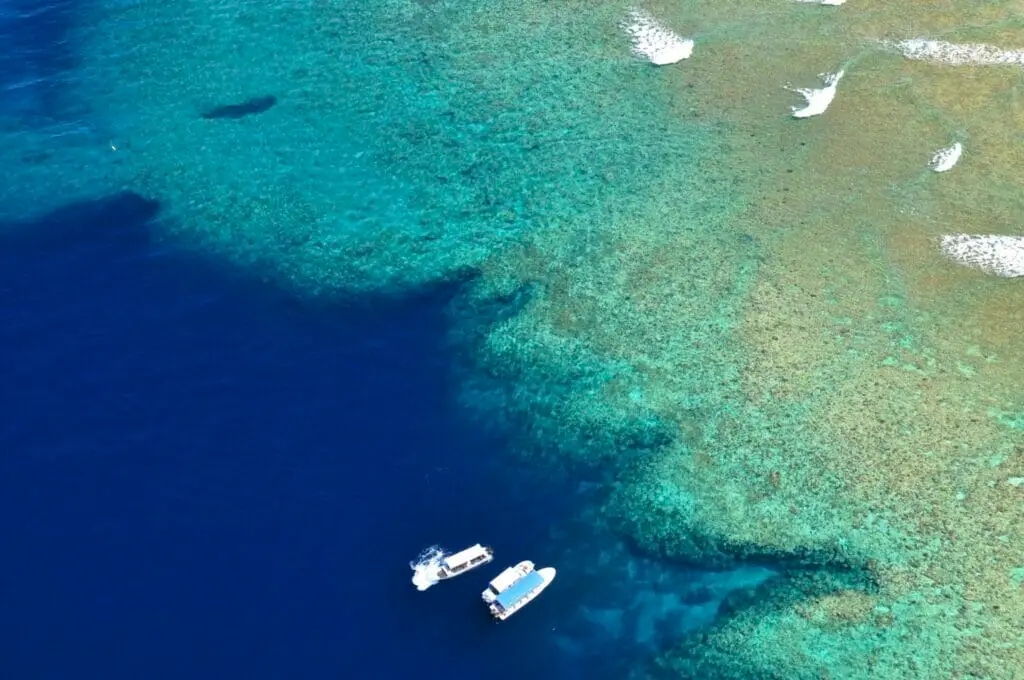
A Smarter Entry: Through Blue Holes
Most of our dives at Blue Corner begin a little upstream — at Blue Holes, a stunning underwater cavern that opens gently onto the reef wall.
Instead of racing into a strong current or rushing to hook in, we:
Drop in calmly above Blue Holes
Descend through the open swim-throughs to around 30 meters (100 feet)
Exit onto the outer reef wall
Drift along with the current, watching the terrain and marine life build
Gradually ascend to the reef plateau at 18–25 meters (60–80 feet)
Find the perfect hook-in spot and settle in for the main event
🧭 This approach is smoother, safer, and way more scenic. You’ll experience two top-tier dive sites in one epic journey.
Understanding the Current (and Why It’s the Whole Point)
Blue Corner is famous for its strong, nutrient-rich currents, and that’s exactly why the site is so alive. Those currents fuel the food chain, bringing in everything from plankton to predators.
The current:
Can flow east-to-west or west-to-east depending on the tide
Often shifts slightly during a dive (our guides anticipate this)
Ranges from mild drift to strong flow, but always manageable with the right plan
Keeps the reef thriving and the action consistent
We monitor current direction and strength daily, and plan each dive for the best possible timing, based on tides, moon phase, and diver comfort.
Dive Profile Snapshot
Entry point: Just above Blue Holes, calm surface conditions
Initial depth: ~30m (100 feet) inside the cavern system
Exit: Onto the outer reef wall, then drift toward Blue Corner
Hook-in zone: Typically 18–25m (60–82 feet) on the reef plateau
Safety stop: On a coral garden, often near a mooring line or sheltered ledge
Because you’ll often be spending extended time around 20–25 meters, diving Blue Corner on Enriched Air Nitrox is a smart choice. It provides longer bottom time, shorter surface intervals, and greater flexibility across multiple dive days.
👉 Learn why Nitrox is ideal for Palau diving
Reef Hook Diving at Blue Corner
How to master Palau’s most iconic technique
If you’ve never used a reef hook before, don’t worry, you’re not alone. For many divers, Blue Corner is their first time using one. And when done right, hooking in feels effortless, meditative, and unforgettable.
At Palau Dive Adventures, we teach and guide you through it—step by step.
What Is a Reef Hook and Why Do We Use It?
A reef hook is a simple tool: a strong stainless-steel hook attached to a 1–2 meter line and clipped to your BCD’s D-ring.
It lets you anchor gently into the reef without damaging it, so you can stay suspended in the current, hands-free, while watching the action unfold.
Why it matters at Blue Corner:
The current here can be strong
The best marine life often gathers just off the reef edge
Without a hook, you’d have to fin constantly to hold position (and risk damaging coral)
Instead, you clip in, let your body go neutral, and fly.
Step-by-Step: How We Hook In at Blue Corner
Arrive as a group at the plateau edge (around 18–25 meters)
Your guide signals the hook-in spot, chosen based on current and safety
You:
Unclip the hook line from your D-ring
Place the hook tip gently into dead coral or rock (never live reef)
Clip the other end to your waist-level D-ring
Inflate your BCD slightly to become neutrally buoyant and rise slightly
Now you’re “flying” just above the reef, totally relaxed
You’ll hover there for 10–20 minutes, watching as sharks, jacks, barracuda, and snapper cruise past in formation, sometimes just meters from your mask.
Is Blue Corner for Beginners?
No. Blue Corner is not a beginner dive site.
This is one of Palau’s most powerful, exposed, and dynamic dive environments, known for strong currents, deep reef walls, and the need for precise control. To dive Blue Corner safely and responsibly, you must hold an Advanced Open Water certification (or equivalent).
At Palau Dive Adventures, we require all divers at Blue Corner to be Advanced certified—not just for insurance or protocol, but because it’s the right level of training for this environment.
Why Advanced Certification Matters
Blue Corner dives can reach depths of 30 meters (100 feet)
You’ll need to manage reef hook gear and maintain buoyancy in a strong current
Entry may begin in an overhead environment (Blue Holes cavern)
You must be able to ascend and descend confidently in open water
There is no direct ascent option for most of the dive
If you’re still working toward your Advanced certification, we recommend diving Palau’s gentler sites first, like Ulong Channel or German Channel, until you’re fully certified and ready for Blue Corner.
Our Responsibility to You, and the Reef
Safety is everything, both for you and the reef.
Bringing underqualified divers into strong currents or onto a delicate reef plateau puts unnecessary pressure on the group, the guide, and the marine ecosystem. Our strict certification requirement ensures:
Safer dives for everyone
Better group control
Longer, more rewarding bottom time
And fewer accidental contacts with the fragile reef
Not Advanced Certified Yet? Here’s Your Path to Blue Corner
If you’re currently an Open Water diver, don’t worry you don’t have to miss out.
At Palau Dive Adventures, we offer the opportunity to complete your Advanced Open Water certification right here in Palau, under the guidance of our experienced instructors.
In just two days, you can:
Complete your required training dives
Build confidence in deeper water and current
Learn essential skills like navigation, buoyancy control, and drift diving
And the best part?
You’ll finish your week by diving Blue Corner—not just as a guest, but as a newly certified Advanced diver.
We’ve guided many divers through this journey, and there’s nothing more satisfying than celebrating your AOW achievement while floating among sharks on one of the world’s greatest dives.
👉 Learn more about getting Advanced certified in Palau
Underwater Photography Tips at Blue Corner
How to capture the magic—without missing the moment
Blue Corner isn’t just thrilling to experience—it’s a dream to photograph. Sharks, schools of fish, sunbeams on the wall, sweeping drift scenes… it’s like shooting an underwater nature documentary in real time.
But with fast current, shifting visibility, and so much happening at once, it pays to have a plan.
Here’s how to make your shots count.
Know What You’re Shooting For
There are three major photo opportunities at Blue Corner:
The Hook-In Scene: Sharks in formation, schools of barracuda, fish riding the current
The Wall Drift: Wide-angle shots of divers drifting past coral and drop-offs
The Plateau Close-Ups: Napoleon wrasse, turtles, triggerfish, and coral details during the final drift or safety stop
Get the Best Position (Literally)
When you’re hooked in:
Keep your fins low and knees bent
Position yourself just off the reef, not on top of it
Face into the current and wait for the marine life to come to you
Avoid spinning or moving too much stillness makes the best subjects
Your guide will help you find a prime hook-in spot with clean line-of-sight to the shark channels and fish funnels.
Camera Gear Tips (For All Levels)
GoPro & Action Cams:
Use a red filter to bring color back at depth
Mount it on a short tray with handles for stability
Avoid constant movement—let the reef come to you
Switch to wide mode to capture the scene, not just the subject
Mirrorless & DSLR:
Use ultra-wide lenses (10–22mm, fisheye, etc.)
Manual white balance at depth or shoot in RAW
Carry with a secure wrist or arm lanyard—hands-free when needed
Skip the strobes at first—sharks prefer ambient light
When (and When Not) to Shoot
It’s easy to get overwhelmed, especially on your first Blue Corner dive. That’s why we often say: “Put the camera down for your first dive. Take it out on your second.”
By then, you’ll know the flow, feel the rhythm of the reef, and have a much better idea where and when to shoot.
We also recommend:
Skipping strobes during hook-in if sharks are shy
Conserving battery for the final drift—turtles, wrasse, and coral life often come closer
Watching your deco and NDL—deep shooting can eat up bottom time fast
Quick Summary:
Best for: Wide-angle, ambient light, action scenes
Top subjects: Sharks, barracuda, jacks, turtles, reefscapes
Hook-in tips: Stay still, stay low, face current
PDA advice: Enjoy your first dive, shoot your second
Camera-ready? Let us know our guides love helping photographers set up for success
When to Dive Blue Corner
Palau is a true year-round diving destination, and Blue Corner is no exception.
Whether you visit during the dry season (Nov–Apr) for peak visibility and shark action, or the lush summer months (May–Oct) for quieter reefs and dramatic skies, this site always delivers.
What changes throughout the year:
Current direction & strength
Fish school density
Shark and pelagic activity
Water visibility after rainfall
At Palau Dive Adventures, we time your dive at Blue Corner based on tides, moon phase, and your comfort level—not just the clock—so you always hit it when the action is on.
👉 Want a deep dive into Palau’s seasons, tide cycles, and marine life patterns?
Why Dive Blue Corner with Palau Dive Adventures?
There are a dozen operators who go to Blue Corner. But how you dive it makes all the difference.
At Palau Dive Adventures, we specialize in small-group, high-attention diving that’s built around one goal: giving you the safest, most thrilling, and most personalized dive experience possible at Blue Corner—and beyond.
Here’s what sets us apart:
Small Groups, Big Experiences
We limit our dive groups to a maximum of 10 divers, often fewer. That means:
No overcrowded boats
More personalized dive plans
Better safety and group cohesion
More time for help with reef hooks, buoyancy, and photography setups
You’ll never feel like a number on a clipboard.
Our Guides Know Every Current
We dive Blue Corner almost every day. That means we:
Know when to go, and when to wait
Understand the subtleties of current direction, tide shifts, and visibility patterns
Time your entry for maximum marine life and minimal crowding
“We don’t just drop and drift. We plan, position, and place you where the action unfold
We Brief, Teach, and Support
First time using a reef hook? Nervous about the current? Need help getting that perfect shot?
We’ve got you covered:
Detailed dive briefings with current maps and visuals
Step-by-step reef hook demos on the boat
In-water assistance for new Advanced divers or photographers
Flexible dive profiles based on your comfort and goals
Two Sites, One Dive
Most of our Blue Corner dives begin at Blue Holes, a stunning cavern just upstream. That means:
You get two epic sites in one dive
You avoid surface crowding and fast drop-ins
You ease into the current at a steady, scenic pace
It’s a calmer, smarter way to dive Blue Corner—designed for comfort, not chaos.
Our Guests Say It Best
“I’ve dived all over the world, and Blue Corner with PDA was something else. The team read the current like a book and put us in exactly the right place. Sharks, jacks, barracuda—it felt like a front-row seat to a National Geographic film.”
— Carla B, AOW diver, 150+ dives
Booking Tips & Final Thoughts
Blue Corner isn’t just a dive site—it’s a dive milestone.
Whether you’re an underwater photographer, a big-animal enthusiast, or simply an experienced diver looking for a world-class thrill, Blue Corner delivers something unforgettable. And diving into it with a team that knows it inside out makes all the difference.
Ready to Dive In?
Here’s how to make it happen:
Check your certification: Advanced Open Water is required
Contact us early—especially during peak season (Nov–Apr)
Let us help plan your week: we’ll optimize your dive schedule based on tides, currents, and your interests
Want to get Advanced certified in Palau? We offer that too, and you can finish your course at Blue Corner



